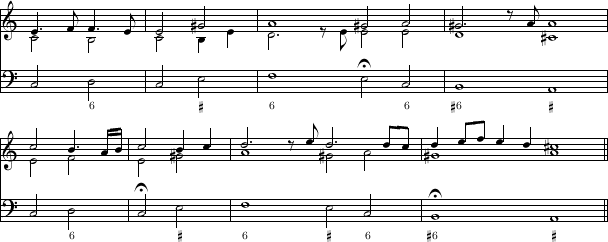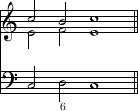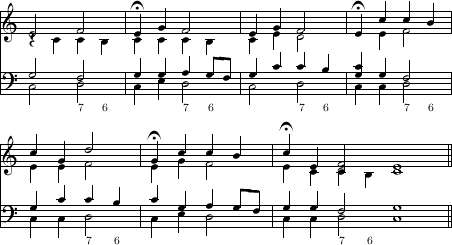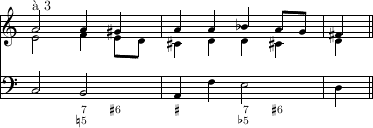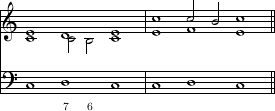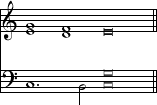previous: cadentia-minor
up: muffat-regulae
next: corrolarium
|
Von der Cadentia minima
Cadentia minima oder die kleine Cadenz ist dreÿerleÿ:
descendens, welche die gebräuchlichste und ordinari ist;
ascendens, so auch tenorizans oder tenorweis gehende Cadenz, und die lezte
stabilis wo der in einer unbeweglichen Noten des Baß bestehet.
|
On the cadentia minima
Cadentia minima or small cadence occurs in three species:
descendens, which is mostly and commonly used; ascendens,
also tenorizans or tenor cadence, and the last stabilis which
consist of a bass staying on a fixed note.
|
De la cadentia minima
Il existe trois sortes de cadentia minima ou petite cadence:
descendens, qui est la plus utilisée et ordinaire; ascendens,
auss tenorizans ou cadence du ténor, et la dernière,
stabilis, dans laquelle la basse reste sur une note fixe. |
|
Von der ordinaria Cadentia minima
In dieser steigt der Baß zu der letzten Noten der Cadenz gradatim ab, zu der
vorletzten aber mag er gehen wie er will.
|
On the ordinary cadentia minima
Therein, the bass descends gradually to the last note, but to the penultimate
note he may go as he likes.
|
De la cadentia minima ordinaire
Dans celle-ci la basse descend conjointement vers la dernière note, mais
elle peut accéder comme elle veut à l'avant-dernière note.
|
|
Diese Cadenz bestehet in dem, daß in der vorlezten Noten sie sich der Sext
major, und zwar entweder allein, wann sie simplex ist, oder mit der
vorangehenden Sept, wann sie ligata oder gebunden, jederzeit bedienet.
|
This cadence is characterised by always using the major sixth at the
penultimate note, either allone when it is simplex, or with the preceeding
seventh when it is ligata or tied.
|
La caractéristique de cette cadence réside dans le fait qu'elle utilise
toujours la sixte majeure sur l'avant-dernière note, soit tout seule, quand
elle est simplex, soit précédée de la septième, quand elle est ligata ou
lièe. |
[p. 115]
Cadentia minima simplex
|
Die Sext major, so in der vorlezten Noten genommen wird, soll in der obern
Stimm allezeit zu der Octav aufsteigen.
|
The major sixth which is taken in the penultimate note, should always ascend to
the octave in the upper voice.
|
La sixte majeure jouée sur l'avant-dernière note, doit toujours monter à
l'octave dans la voix supérieure.
| |
Gut
|
Good
|
Bon
|
|
|
Schlechte Manieren
|
Bad manner
|
Mauvaises manières
|
|
|
Gebundene mit der Septima
|
Tied with the seventh
|
Lièe avec la septième
|
|
|
|
|
[p. 116] Anderst
|
Differently
|
Différemment
|
|
|
|
|
|
|
Noch völliger
|
Even fuller
|
Encore plus plein
|
|
|
[p. 117]
Mit der Sext major der vorletzten Noten nimbt die welsche Manier mit 4 oder
mehr Stimmen auch ein Quart neben der Terz an, zu welcher Quart nit soll
gesprungen werden und welche hernach unbeweglich bleibt.
|
With the major sixth of the penultimate note the "welsh" manner with four or
more voices accepts also a fourth next the third, to which fourth one should
not jump and which rests fixed afterwards.
|
Quand la sixte majeure est sur l'avant-dernière note, la manière welche à
quatre voix accepte aussi la quarte à coté de la tierce; on ne doit pas
accéder à cette quarte par un saut et celle-ci ne doit pas rester fixe ensuite.
|
|
|
|
|
Wann die vorlezte Noten im Baß ein mi oder dur Noten ist, gibt man ihr offt
auf welsche Manier die kleine falsche Quint, wann es ohne dem der Ton
erfordert; soll aber gradatim geschehen und hernach abwerts resolvirt werden.
|
When the penultimate note in the bass is a mi or hard note, one often
adds in "welsh" manner the small false fifth, when the key demands it already;
but this should happen gradually and should afterwards be resolved gradually
downwards.
|
Quand l'avant-dernière note dans la basse est un mi ou une note dure,
on lui ajoute souvent la petite fausse quinte à la manière welche, quand la
tonalité l'exige de toute façon; on doit procéder conjointement et résoudre
ensuite. |
|
|
|
|
[p. 118]
|
Völliger
|
Fuller
|
Plus plein
|
|
|
Langweilige Cadenz minima
|
Boring Cadenz minima
|
Cadence minima ennuyeuse
|
|
|
Langweilig
|
Boring
|
Ennuyeux
|
|
|
Aufgemuntert und geziert
|
Gingered up and adorned
|
Animée et ornée
|
|
|
[p. 119]
Cadentia minima tenorizans oder ascendens, wo der Baß zu der letzten Noten der
Cadenz durch Semitonium majus hinaufsteigt, wird gemeiniglich mit der Secunda
subsÿncopata geschlagen.
|
Cadentia minima tenorizans or ascendens, where the bass
ascends at the last note of the cadence by a big half note, it is normally
played with the secunda subsyncopata.
|
La cadentia minima tenorizans ou ascendens, dans laquelle la
basse monte sur la dernière note par un grand demi ton, est jouée normalement
avec la secunda subsyncopata.
|
|
|
|
|
Anderst
|
Differently
|
Différemment
|
|
|
Langweilig
|
Boring
|
Ennuyeux
|
|
|
|
|
Aufgemuntert
|
Gingered up
|
Animé
|
|
|
[p. 120] In übrigen besihe, was in den Regeln von der Secunda subsÿncopata, wie
auch in den Exempeln von den per Semitonium aufsteigenden Sextil gesagt worden.
|
Otherwise cf. what has been told in the rules about the seconda
subsyncopata, as well as in the examples of the sextil which
ascends by a half note.
|
Sinon, il faut voir ce qui était dit dans les règles de la secunda
subsyncopata et ainsi que les exemples du sextil montant par un
demi-ton.
| |
Cadentia minima stabilis oder unbewegliche kleine Cadenz
geschicht auf eine einzige Noten des Baß mit der Würkung solcher folgenden
Concenten und lautet fast wie die Cadenz minor.
|
Cadentia minima stabilis or fixed small cadence happens upon
one single note of the bass by action of the following chords and it sounds
almost like the minor cadence.
|
La cadentia minima stabilis ou petite cadence fixée se fait
entendre sur une seule note de la basse avec l'action des accords suivants et
elle sonne presque comme la cadence mineure.
|
|
|
|
|
|
|
Also soll die oberste Stimm allzeit gehen.
|
The upper most voice should always go like this.
|
La voix supérieure doit toujours avancer ainsi.
| |
Gut
|
Good
|
Bon
|
|
|
|
|
noch schöner
|
Even nicer
|
Encore plus beau
|
|
|
|
|
|
|
Und so fort; dann wann nur diese Sept rect anfangs gebunden wird, das übrige
gehet, wie oben gezeit worden.
|
Etc; if only this right sixth is tied at the begin, the rest will go like has
been demonstrated above.
|
Etc; dans l'unique cas où cette septième juste est liée au départ, le reste
se déroule comme montré ci-dessus.
| |
In übrigen besihe die Eigenschafft dieser Concenten in ihren absonderlichen
Regeln, wodurch sie leicht mit mehrern zu fillen.
|
Otherwise cf. the character of these chords in their corresponding rules, by
which they can easily be filled with more.
|
Sinon, il faut observer ce qui est dit dans les règles concernant les
particularités de chacun de ces accords; il sont ainsi faciles à remplir. |
last modified Wed Mar 14 15:02:23 2007 by Bernhard Lang previous: cadentia-minor
up: muffat-regulae
next: corrolarium
|


